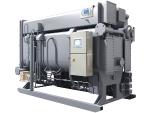
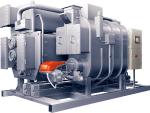
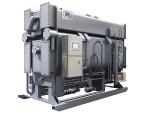
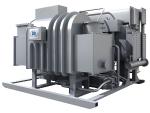
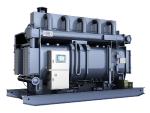
The words lithium bromide have been part of the refrigeration equipment lexicon as long as there has been absorption refrigeration. True to its name, the LiBr absorption unit utilizes LiBr to absorb refrigerant vapors and produce either chilled water for cooling applications or hot water for heating purposes.
To power the absorption refrigeration cycle, a heat source is needed, which can be steam, hot water, and exhaust gas, or from direct combustion of oil or natural gas. The unit is widely used in the air conditioning system, industrial process, or the district heating system.
For those who are considering replacing their aged, worn-out chillers with our high-efficiency models, here is what you might be interested in.
Working Principle
A pump is used to draw the dilute solution from the absorber. The solution is slightly heated in a heat exchanger before entering the generator. Once inside the generator, hot water is used to heat up the solution while the refrigerant in the solution vaporizes. The resulting solution becomes thicker than before.
This concentrated solution flows past the tubes of a heat exchanger, where it transfers its heat to the cold dilute solution that flows through the tubes. After heat transfer, the cold thick solution returns to the absorber. The vaporized refrigerant passes through a condenser where it is condensed by cooling water that flows inside the condenser core. After condensing, the excess heat is emitted to the atmosphere.
The cold refrigerant liquid then enters an evaporator via a series of U-shaped tubes. Due to the low pressure inside the evaporator, a portion of liquid refrigerant spontaneously vaporizes and turns into flash-gas while the rest forms a saturated solution due to loss of heat as a result of the vaporization process. The cold, saturated solution gradually drains into a drip tray in the evaporator. At this point, another pump is used to draw the solution and spray it over the heat transfer tube surface of the evaporator.
The solution then absorbs enough heat from water which flows through the heat transfer tube. It boils and vaporizes. The resulting vapor, together with the flash-gas, is absorbed by the concentrated solution in the absorber.
The water, after heat transfer, becomes colder and drains out of the absorption refrigeration unit. It returns to the air conditioning system to be used as water coolant. The thick concentrated solution, after absorbing the refrigerant vapor, is gradually thinned into a dilute solution. In this way, the absorption refrigeration cycle can repeat, with the evaporator continuously producing cold water at the required temperature.
Advantages
1. This lithium bromide absorption refrigerator uses little amount of electricity, which brings a considerable amount of electrical cost savings.
2. The whole cycle operates stably, providing years of continuous service.
3. High efficiency, minimized energy use
4. Eco-friendly system helps reduce harmful emissions. It does not use Freon as refrigerant which might do harm to our health and living environment.
5. Easy maintenance